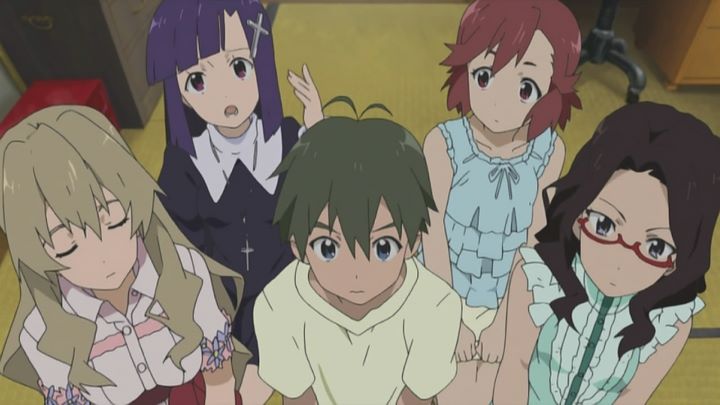






The opening theme of "Kannagi - Crazy Shrine Maidens" is of the lead character, Nagi, dancing on stage as a Japanese idol while singing a pop song. It shows a montage throughout the lyrics of Nagi's life as a celebrity, being guided by her bodyguard, trained by a dance instructor, and acting in a feature film. This is meant to be a tongue-in-cheek joke. In the show, Nagi is NOT an idol, and this opening similarly uses cameos of all the other characters in roles that have nothing to do with the show. It's clever and cute, although the joke probably flies over the viewer's head in the first one or two episodes.But here's the thing: even though the plot is really about a cute girl who becomes a manifestation of a forgotten Japanese shrine goddess, it does at one point suggest that Nagi must gain more "followers" in order to build back her powers, at which point she outright claims she must become the town's "idol." As such, the show surprises the viewer by doing exactly what it said it would against the viewer's expectations... except it then completely ignores what it just said, and proceeds to follow a different tangent that has nothing to do with the idol industry. "Kannagi" does this type of wall-breaking often, sometimes in clever ways, and mostly around the concept of not knowing what it wants to be. But in doing so, IT DOESN'T KNOW WHAT IT WANTS TO BE, and the plot suffers from a lack of any payoff.The animation was handled by Studio A1-Pictures. At the time, it was a fairly new studio, only having formed in 2005. As such, "Kannagi: was one of their first titles (originally based off a manga that continued publication until 2017); "Black Butler" was their only other notable show from this time, although they later would become household names for anime fans with titles including "Fairy Tail," "Sword Art Online" and many others. Their production values can vary, as they are more known for quantity over quality in the effort to be a mainstream production house, but their quality does come through at unexpected times. With "Kannagi," while the character designs are simple and straightforward, and the backgrounds painterly but plain like most other shows, I was nonetheless impressed with the fluidity and subtlety of the character animation in the first two episodes. For the most part, the show consists of people talking and not much else, but these first episodes had a high frame rate of movement, showing subtle detail in facial expressions, walking, or moving strands of hair out of the way. It makes a great first impression with the plot, wherein a blue-haired girl magically appears in front of high-school student Jin, forming a human girl from inside a sculpture made from wood of a sacred tree from a now torn-down shrine. The girl claims to be Nagi, a shrine goddess whose duty is to protect the town from bad spirits, and enlists Jin to help her as well as give her free housing, while Jin remains suspecious of her lack of memory. However, the plot quickly changes when we see Jin attending school. He is a member of the art club (a group of student outcasts), looking up to the talent of others while being unable to figure out where he fits in life. Naturally, Nagi becomes a student to hang-out with Jin and to find other impure spirits on the school grounds. Here, it is clear the show is a comedy first, and the animation changes to meet that, but still impresses in the creativity and detail of its gag-reactions for characters in jokey moments. We also get a sense of Nagi's connections with other characters, including another student who claims to be her sister, also a shrine maiden from centuries past, taking over the body of a real student to stay in the real world.But after the first four episodes or so, the show starts to get lazy. It falls too heavily on the romantic triangle (or eventually, pentagon) between Jin and every other character. It becomes a daily slice-of-life at a anime high-school, completely forgetting about the quest to fight the demons who haunt the town in favor of going to a maid cafe or a group karaoke session. By this point, the animation has dropped to ranging from mediocre to on-par with any other show from 2008, matching filler-plot with filler-visuals. The lack of variety in the visuals and the limitations of digi-paint are all the more obvious by this point on. There are a handful of brief moments where the brilliance of the first few episodes come back in the animation, but these are few and far between, and only last seconds at a time. By the ending, several plot-threads are left unsolved, the audience knows little about Nagi or her existance beyond what the first episode provided, character logic mismatches with their original designs from episodes prior, and we're left desparate for a sequel season or film to tie everything together. This never came... I guess the manga might provide something more substantial, given that most of it was unfinished by the time the show originally aired. So the show is disappointing from a plot standpoint. But if you do like comedy, the show has that in spades as the one constant it follows. The show likes visual gags and more subtle dialogue jokes, and makes references to other anime (obscure and well-known) and breaks the fourth wall often. At one dramatic moment, it even addresses that the plot had forgotten its original purpose, and points a finger at being unable to decide what it wants to be (it claims a character feels this way about themselves, but it is a clear connection to the production as a whole). In some cases, the jokes are laugh-out-loud funny, and in others the comments seem smart. But breaking the fourth-wall can be over done, and that certainly feels true with "Kannagi." At the very least, if the show is critiquing itself, it should finish with a conclusion that makes itself better: instead, the show typically falls back on "but-I'm-a-cute-character-and-I'm-sorry-won't-you-love-me?"I think maybe the show gambles to much on the lovability of Nagi. She's young and naive to the modern world, but stuck-up and expects everyone to feed her and provide her shelter for free, for she is a goddess after all. It isn't on the level of "quirky and mean-spirited" like Haruhi Suzumiya (which this show clearly took a bit of inspiration from, like most other shows of this era), but more of a "bratty little-sister" persona. I didn't buy it. I kept waiting to learn more about her supposed place in the town's history, her connection with Jin as a child, the growth of her powers and her taking a rightful place as a shrine priestess, or else disappearing from reality in a tearful goodbye. I wanted the show to act on the ominous and serene ending song it ends each episode with. Instead, I got a stubborn and childish girl with no backstory, not unlike the background characters of dozens of other anime before and after. Again, the show points this out of her, but doesn't act on its own criticisms. Sigh."Kannagi" was released on DVD in North America under Bandai Entertainment in 2009, going out of print after the company's bankrupcy and not being rescued ever since. I have a soft-spot for buying the release brand-new at an anime convention marketplace in 2017, at it original retail value (a reasonably good deal compared to other marked-up out-of-print shows), one of the first such purchases I ever made at a convention. Aside from this circumstance, there is little for me to recommend the show outright. I do recommend trying to watch the first few episodes if accessible, if nothing else to get an idea of anime from this time-period of anime culture and to see the history of A1-Pictures for a sense of what they would make next.
So the show is disappointing from a plot standpoint. But if you do like comedy, the show has that in spades as the one constant it follows. The show likes visual gags and more subtle dialogue jokes, and makes references to other anime (obscure and well-known) and breaks the fourth wall often. At one dramatic moment, it even addresses that the plot had forgotten its original purpose, and points a finger at being unable to decide what it wants to be (it claims a character feels this way about themselves, but it is a clear connection to the production as a whole). In some cases, the jokes are laugh-out-loud funny, and in others the comments seem smart. But breaking the fourth-wall can be over done, and that certainly feels true with "Kannagi." At the very least, if the show is critiquing itself, it should finish with a conclusion that makes itself better: instead, the show typically falls back on "but-I'm-a-cute-character-and-I'm-sorry-won't-you-love-me?"I think maybe the show gambles to much on the lovability of Nagi. She's young and naive to the modern world, but stuck-up and expects everyone to feed her and provide her shelter for free, for she is a goddess after all. It isn't on the level of "quirky and mean-spirited" like Haruhi Suzumiya (which this show clearly took a bit of inspiration from, like most other shows of this era), but more of a "bratty little-sister" persona. I didn't buy it. I kept waiting to learn more about her supposed place in the town's history, her connection with Jin as a child, the growth of her powers and her taking a rightful place as a shrine priestess, or else disappearing from reality in a tearful goodbye. I wanted the show to act on the ominous and serene ending song it ends each episode with. Instead, I got a stubborn and childish girl with no backstory, not unlike the background characters of dozens of other anime before and after. Again, the show points this out of her, but doesn't act on its own criticisms. Sigh."Kannagi" was released on DVD in North America under Bandai Entertainment in 2009, going out of print after the company's bankrupcy and not being rescued ever since. I have a soft-spot for buying the release brand-new at an anime convention marketplace in 2017, at it original retail value (a reasonably good deal compared to other marked-up out-of-print shows), one of the first such purchases I ever made at a convention. Aside from this circumstance, there is little for me to recommend the show outright. I do recommend trying to watch the first few episodes if accessible, if nothing else to get an idea of anime from this time-period of anime culture and to see the history of A1-Pictures for a sense of what they would make next.